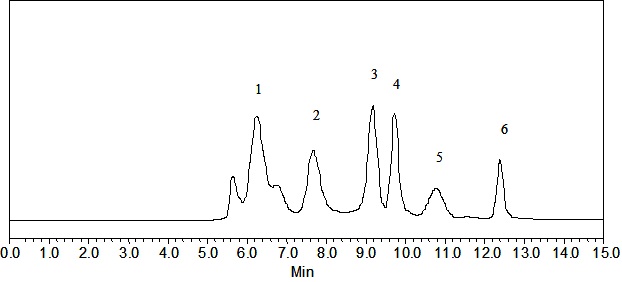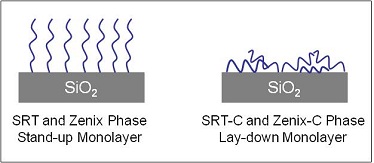| Description | Packing | Characteristics | Application | Order Info | Downloads |
SRT ®-C SEC phase, developed based on innovative surface coating technology, comprises of uniform, hydrophilic, and neutral nanometer thick film chemically bonded to high purity and mechanically stabilized silica. SRT ®-C, uses lay-down monolayer on porous silica as oppose to SRT of stand-up monolayer (as shown below), offers ideal phase chemistry for hydrophobic samples like insulin, membrane protein monoclonal antibodies derivatized with polymer branches (polypeptide or PEG) separation.
Stationary Phase Structure Illustration and Comparison
Phase structure difference: a monolayer stands up on the silica surface for SRT ® and Zenix™, and a monolayer lays down on the silica surface for SRT ®-C and Zenix™-C.
Sepax SEC Product Family Comparison Chart
| Product Line | SRT® | Zenix™ | SRT®-C | Zenix™-C |
|---|
| Particle size | 5 µm | 3 µm | 5 µm | 3 µm |
| Pore size (Å) | 100, 150, 300, 500, 1000 & 2000 | 100, 150, 300 | 100, 150, 300, 500, 1000 & 2000 | 100, 150, 300 |
| Resolution | High | Highest, Short column for faster separation | High | Highest, Short column for faster separation |
| Efficiency | High | Doubled from 5µm | High | Doubled from 5µm |
| Selectivity | Same for SRT® and Zenix™ | Same for SRT®-C and Zenix™-C |
| Surface structure | Chemically bonded stand-up monolayer | Chemically bonded lay-down monolayer |
| Recommended Sample Types | Monoclonal antibodies, proteins, peptides, nucleic acids, oligonucleotides, virus, and water-soluble polymers | "Tough samples" such as hydrophobic proteins like insulin, membrane protein monoclonal antibodies derivatized with polymer branches, e.g. polypeptide, PEG. |
SRT®-C Technical Specifications
| Phase |
SRT®-C SEC-100 |
SRT®-C SEC-150 |
SRT®-C SEC-300 |
SRT®-C SEC-500 |
SRT®-C SEC-1000 |
SRT®-C SEC-2000 |
|---|
| Material | Neutral, hydrophilic film bonded silica |
|---|
| Particle size | 5 µm |
|---|
| Pore size |
~ 100 Å |
~ 150 Å |
~ 300 Å |
~ 500 Å |
~ 1000 Å |
~ 2000 Å |
|---|
| Protein MW range (native) [Da] |
100 - 100,000 |
500 - 150,000 |
5,000 - 1,250,000 |
15,000 - 5,000,000 |
50,000 - 7,500,000 |
> 10,000,000 |
|---|
| pH stability | 2.5 – 7.5 (up to pH 8.5 can be tolerated temporarily*) |
|---|
| Backpressure | ~ 700 psi (for a 7.8×300 mm) |
|---|
| Maximum backpressure [psi] |
~ 4,500 |
~ 4,500 |
~ 3,500 |
~ 3,000 |
~ 3,000 |
~ 3,000 |
|---|
| Salt concentration range | 20 mM – 500 mM |
|---|
| Maximum temperature | ~4 – 40°C |
|---|
| Mobile phase compatibility | Aqueous and organic |
|---|
- Ideal for separation and analysis of hydrophobic proteins, and monoclonal antibodies derivatized with polymer branches such as polypeptide or PEG
- Particle size of 5 µm
- Selection of pore size: 100, 150, 300, 500, 1,000, and 2,000 Å
- High separation efficiency and resolution
- High capacity
- High lot-to-lot reproducibility
- High protein recovery with intact biological activity
- Negligible non-specific interactions
Separation of a protein mixture by SRT-C SEC-300 column.
 |
| Conditions | |
| Columns: | SRT-C SEC-300(5 µm, 7.8×300mm) |
| Mobile phase: | 150 mM Sodium Phosphate, pH 7.0 |
| Flow rate: | 1.0 mL/min |
| Temperature: | Ambient (~23 °C) |
| Detection: | UV 214 nm |
| Injection volume: | 10 µL |
| Samples: | 1) Thyroglobulin, 670kD
2) γ-Globulin, 158kD
3) Ovalbumin, 44kD
4) Myoglobin, 17.6kD
5) Poly-DL-alanine (1-5 kD)
6) Uracil, 120D |
|
Protein MW calibration with elution volume for SRT-C phases.
| Conditions | |
| Columns: | SRT-C (5 µm, 7.8×300mm) |
| Mobile phase: | 150 mM Sodium Phosphate, pH 7.0 |
| Flow rate: | 1.0 mL/min |
| Detection: | UV 214 nm |
| Injection volume: | 10 µL |
| Samples: | 1. Thyroglobulin, 670kD
2. γ-Globulin, 158kD
3. BSA, 66kD
4. Ovalbumin, 44kD
5. Myoglobin, 17.6kD
6. Ribonuclease A, 13.7kD
7. B12, 1.35kD
8. Uracil, 120D |
|
 |
| |









